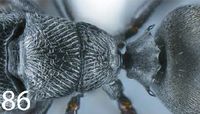Polyrhachis monticola
| Polyrhachis monticola | |
|---|---|

| |
| Scientific classification | |
| Kingdom: | Animalia |
| Phylum: | Arthropoda |
| Class: | Insecta |
| Order: | Hymenoptera |
| Family: | Formicidae |
| Subfamily: | Formicinae |
| Tribe: | Camponotini |
| Genus: | Polyrhachis |
| Subgenus: | Aulacomyrma |
| Species: | P. monticola |
| Binomial name | |
| Polyrhachis monticola Kohout, 2007 | |
Known from a single worker collected foraging on low vegetation.
Identification
Kohout (2007) - P. monticola is rather similar to Polyrhachis annulata and Polyrhachis breviata and shares with them the somewhat antero-posteriorly compressed body and the medially emarginate dorsal petiolar margin. However, monticola is easily separated by the sculpture of the mesonotal-propodeal dorsum that consists of V-shaped, posteriorly converging striae, while in annulata and breviata the striae form virtual semicircles or U-shaped patterns.
Keys including this Species
Distribution
Distribution based on Regional Taxon Lists
Indo-Australian Region: New Guinea (type locality).
Distribution based on AntMaps
Distribution based on AntWeb specimens
Check data from AntWeb
Countries Occupied
| Number of countries occupied by this species based on AntWiki Regional Taxon Lists. In general, fewer countries occupied indicates a narrower range, while more countries indicates a more widespread species. |

|
Estimated Abundance
| Relative abundance based on number of AntMaps records per species (this species within the purple bar). Fewer records (to the left) indicates a less abundant/encountered species while more records (to the right) indicates more abundant/encountered species. |

|
Biology
|
Castes
Known only from the worker caste.
Nomenclature
The following information is derived from Barry Bolton's Online Catalogue of the Ants of the World.
- monticola. Polyrhachis (Aulacomyrma) monticola Kohout, 2007a: 230, figs. 83, 86, 89 (w.) NEW GUINEA.
Unless otherwise noted the text for the remainder of this section is reported from the publication that includes the original description.
Description
Worker
Holotype: TL c. 5.19; HL 1.37; HW 1.25; CI 91; SL 1.40; SI 112; PW 1.00; MTL 1.31.
Anterior clypeal border arcuate, emarginate medially; clypeus straight in profile, basal margin weakly impressed, laterally indicated by distinct line breaking cephalic sculpture. Frontal carinae with lamellate lobes. Sides of head weakly convex in front of eyes, rounding behind into weakly convex preoccipital margin. Eyes moderately convex, only marginally exceeding lateral cephalic outline. Mesosomal dorsum immarginate for most of length, distinctly converging posteriorly. Pronotal humeri armed with broad-based, triangular, dorso-ventrally flattened teeth. Promesonotal suture relatively shallow, distinctly incised laterally; metanotal groove only weakly indicated by faint break in sculpture. Mesonotal dorsum with outermost dorsal striae forming an ill-defined lateral margin. Propodeal dorsum immarginate, terminating posteriorly in small rounded prominences formed by inwardly curved lateral striae; medially dorsum sloping into declivity in rather abrupt, uninterrupted curve. Dorsal margin of petiole with acute intercalary teeth, bordering medial emargination, margin jagged laterally, terminating in relatively long, strongly backward- curved spines with weakly upturned tips. First gastral segment concave anteriorly; concavity with blunt dorsal margin that is not elevated above dorsal surface of segment.
Mandibles finely, somewhat irregularly, longitudinally striate-rugose. Sculpture of head consisting of regularly spaced striae; V-shaped on clypeus and mostly longitudinal on sides; striae on vertex converging anteriorly between and along frontal carinae. Striae on pronotal dorsum strongly converging anteriorly; striae on mesonotal-propodeal dorsum converging posteriorly, forming V-shaped pattern; laterally striae continued obliquely onto sides. Petiole with both faces microscopically shagreened. First gastral segment distinctly, longitudinally striate laterally; dorsally striae becoming finer and less distinct, medially and anteriorly finely shagreened.
A few short, erect or curved, yellowish hairs on head, including mandibular masticatory border, anterior clypeal margin, sides of head between eyes and posterolateral corners and along leading edges of antennal scapes; hairs absent between eyes and bases of mandibles or along inferior edges of scapes. Mesosomal dorsum and first gastral segment with a few short erect hairs, variously curved. Petiole with several very short hairs fringing dorsal margin. Apex of gaster with numerous, relatively long, golden hairs. Mostly silvery, very sparse appressed pubescence on head; more abundant on pronotal humeri, propodeal dorsum, sides and upper portion of declivity, coxae, petiole and posterior margins of gastral segments; first gastral segment with distinctly golden pubescence almost obscuring sculpture.
Black; antennae, femora, bases of tibiae and basal tarsal segments very dark reddish-brown. Tip of last funicular segment, distal ends of trochanters, most of tibiae and tarsi, light to very light reddish-brown.
Type Material
HOLOTYPE: PAPUA NEW GUINEA, Morobe Prov., Sarawaget Ra., 3km E of Gain, 06º25’S, 146º46’E, 1000-1200m, rf., 26.viii.1984, R. J. Kohout acc. 84.363 (worker). Type deposition: unique holotype in Australian National Insect Collection.
Etymology
Name derived from the Latin word montis, meaning mountain.
References
References based on Global Ant Biodiversity Informatics
- Janda M., G. D. Alpert, M. L. Borowiec, E. P. Economo, P. Klimes, E. Sarnat, and S. O. Shattuck. 2011. Cheklist of ants described and recorded from New Guinea and associated islands. Available on http://www.newguineants.org/. Accessed on 24th Feb. 2011.
- Kohout R.J. 2007. Revision of the subgenus Aulacomyrma Emery of the genus Polyrhachis F. Smith, with descriptions of new species (pp. 186-253). In Snelling, R.R., Fisher, B.L. & Ward, P.S. (eds). Advances in ant systematics: homage to E.O. Wilson 50 years of contributions. Memoirs of the American Entomological Institute 80: 690 pp.

